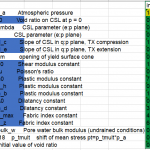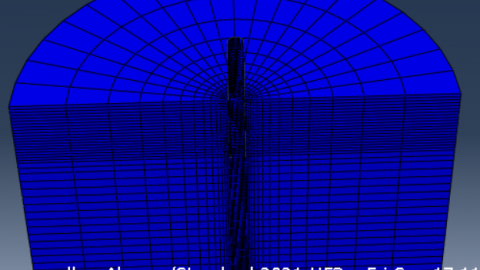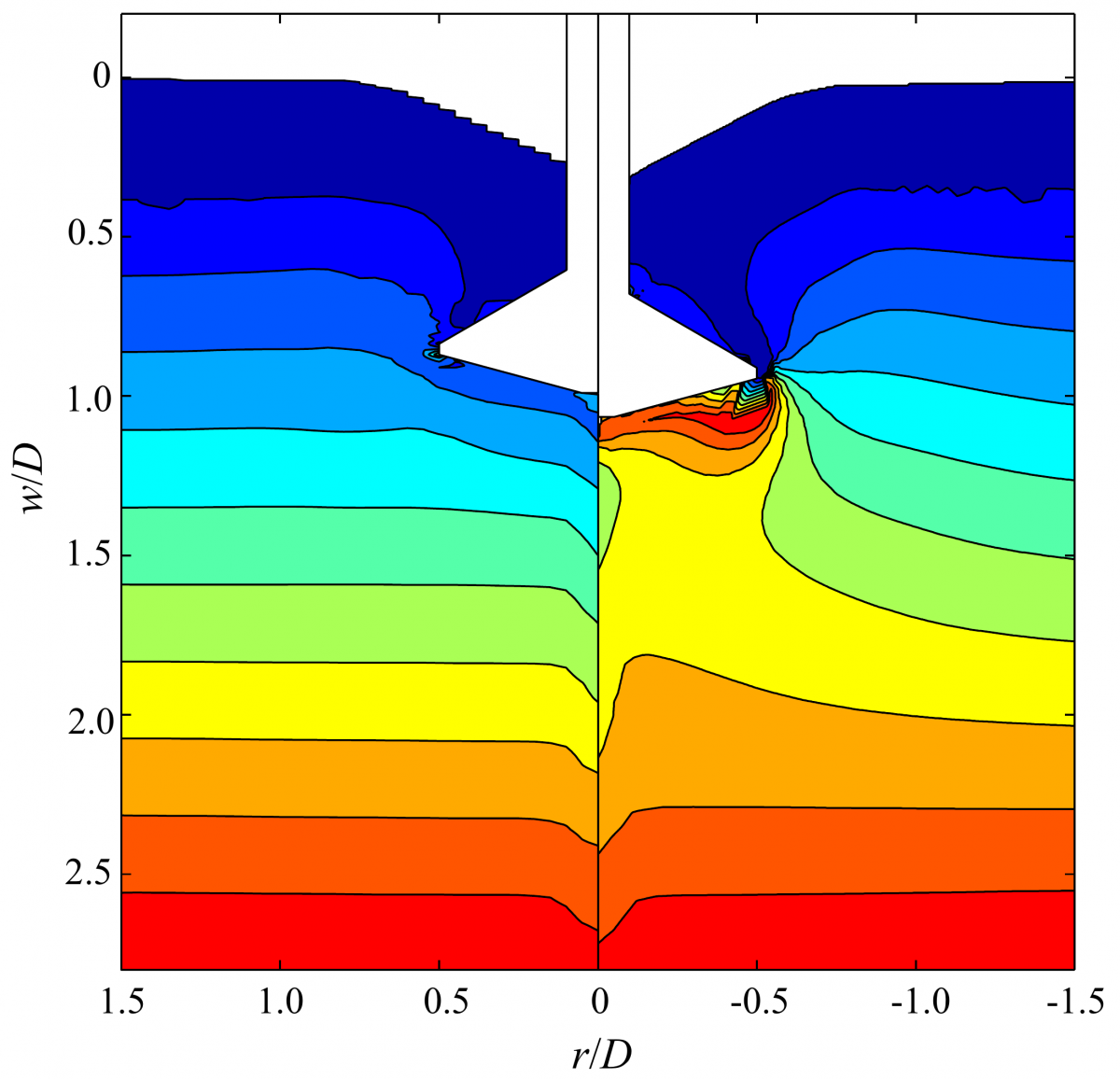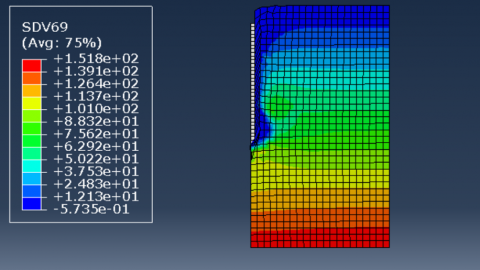Dear all,
I’m trying to model multilayer soil in abaqus. To use the SaniSand umat in model I use the following parameters but no plastic strain at all. The unit system used is us(in). Are the input parameters incorrect?
Could anyone kindly help me solve this problem? Thanks a lot!.
problem with sanisand umat
Related Articles
-
How to model the settlement in soil due to water drawdown.
 Guru Panda||Finite Elements|5 |Views 4,004
Guru Panda||Finite Elements|5 |Views 4,004
Which software has the feature to model soil settlement due water drawdown? -
Abaqus OneAPI Compiler
 Kassem Dib||Finite Elements|1 |Views 7,761
Kassem Dib||Finite Elements|1 |Views 7,761
Hello.. I am testing SaniSand constitutive model as published by Mr. Masin at this site. The Abaqus is V21 and the visual studio 2017 with OneAPI compiler, the Abaqus verification […] -
Hypoplastic model for clays in a Plaxis 2D simulation – Problem
 Daniel Valencia||Finite Elements|2 |Views 3,274
Daniel Valencia||Finite Elements|2 |Views 3,274
Hello everybody, Using Hypoplastic model for clays, with intergranular concept parameters, I am simulating a simple oedometer test, phase by phase, using a dummy layer on the top of the […] -
Some confusion about the parameters in Abaqus umat of Hypoplastic Modeling
 Joe Chu||Finite Elements|1 |Views 3,360
Joe Chu||Finite Elements|1 |Views 3,360
Dear all, When I check the umat file of sand hypoplastic modeling, I find there are two parametesr(p_t(2), bulk_w(15)) without any definitions. Could someone kindly explain the exact meaning for […] -
Problem in simulating CPT using SANISAND04
 an zhanng||Finite Elements|6 |Views 1,449
an zhanng||Finite Elements|6 |Views 1,449
I have a question regarding the simulation of cone penetration tests using the SANISAND04 model. I have observed that the parameter m (yield surface size)has a significant impact on the […] -
Hypoplasticity sand convergence issues
 anis kheffache||Finite Elements|0 |Views 3,451
anis kheffache||Finite Elements|0 |Views 3,451
Hi everyone, i am modeling laterally loaded monopile using abaqus, My 3d model looks like this, only half of the model is simulated, symmetry boundary conditions is applied to the […] -
Presentations on hypoplasticity applications, D. Mašín, NGI 2017
 David Mašín||Finite Elements|0 |Views 5,022
David Mašín||Finite Elements|0 |Views 5,022
Based on some requests, I share here two presentations on hypoplasticity applications. One is related to simulation of various boundary value problems, the other focuses on simulation of cyclic and […] -
sigini ans sdvini subroutine example for soil model in Abaqus
 Safia EDAOUDI||Finite Elements|0 |Views 1,054
Safia EDAOUDI||Finite Elements|0 |Views 1,054
Dear all, I’m looking for a sigini and sdvini subroutine examples to calculate soil initial state with rest coeficient K0 method or ICP-05 method or any method available. thank you. […]
Who is Online
No one is online right now
Search SoilModels Website
Recent posts
-
 Degradation ( disturbance ) of hypoplastic clay 23.4.2024
Degradation ( disturbance ) of hypoplastic clay 23.4.2024
-
 Degradation ( disturbance ) of hypoplastic clay 23.4.2024
Degradation ( disturbance ) of hypoplastic clay 23.4.2024
-
 Paper of Coulomb, C. A. (1773) 15.4.2024
Paper of Coulomb, C. A. (1773) 15.4.2024
-
 ABAQUS UMAT of hypoplastic clay model 6.4.2024
ABAQUS UMAT of hypoplastic clay model 6.4.2024
-
 Prague Geotechnical Days 2024 “Geotechnical monitoring” and 30th jubilee Prague Geotechnical Lecture by prof. Eduardo Alonso 5.4.2024
Prague Geotechnical Days 2024 “Geotechnical monitoring” and 30th jubilee Prague Geotechnical Lecture by prof. Eduardo Alonso 5.4.2024
-
 UMAT for Creep-SCLAY model. 1.3.2024
UMAT for Creep-SCLAY model. 1.3.2024
-
 Cyclic tests with Triax element test driver 14.2.2024
Cyclic tests with Triax element test driver 14.2.2024
-
 SUMMER SCHOOL ‘Numerical Modelling in Geotechnical Engineering’, Innsbruck – July 22nd-26th, 2024 1.2.2024
SUMMER SCHOOL ‘Numerical Modelling in Geotechnical Engineering’, Innsbruck – July 22nd-26th, 2024 1.2.2024
-
 COURSE IN SOIL MODELING – NTNU, Trondheim – October 14th to 18th, 2024 21.12.2023
COURSE IN SOIL MODELING – NTNU, Trondheim – October 14th to 18th, 2024 21.12.2023
-
 MSE walls design in Plaxis 11.12.2023
MSE walls design in Plaxis 11.12.2023
-
 sand liquefaction modelling in Anura3D 8.12.2023
sand liquefaction modelling in Anura3D 8.12.2023
-
 BCV bentonite experimental and modelling datasets 14.11.2023
BCV bentonite experimental and modelling datasets 14.11.2023
Recent Comments
- Zhentao Liu on Problem in simulating CPT using SANISAND04
- Gertraud Medicus on ABAQUS UMAT of hypoplastic clay model
- Chen Zhiming on Download Package of Charles University Implementation of High Cycle Accumulation Model
- Konstantinos Chatzis on Cyclic tests with Triax element test driver
- Abhay Pratap Singh on Cyclic tests with Triax element test driver
- Giovanni Ciardi on Cyclic tests with Triax element test driver
- Konstantinos Chatzis on Cyclic tests with Triax element test driver
- Ismail Khan on Cyclic tests with Triax element test driver
- Kanika Lamba on Cyclic tests with Triax element test driver
- Arie Koot on How to model the settlement in soil due to water drawdown.
- Konstantinos Chatzis on Cyclic tests with Triax element test driver
- Jose Duque on Cyclic tests with Triax element test driver
- MohamadReza Kamali on How to model the settlement in soil due to water drawdown.
- Leo Alibert on MSE walls design in Plaxis
- Ignacio Zuloaga on MSE walls design in Plaxis
- Giada Orlando on Problem with VUMAT interface
- Michael Spyridis on Problem with VUMAT interface
- Ahmad Moeineddin on Problem with VUMAT interface







Hey Yousef
The parameters look generally ok. Rather close to the original calibration of Dafalias & Manzari for Toyoura Sand. If you are using US units check if your G0 parameter, which is indeed unitless, is still 125 or is it different value.
Good luck
Piotr
Hello
Thank you for replay
G0 is a dimensionless constant, but by changing its value, PE is STEEL equal to zero.
Hey Yousef
As mentioned by Arie, PE is not calculated by the umat. It is calculated only by the constitutive models implemented in Abaqus. If you want to see if plastic strains occur from the umat, then read umat carefully and try to ask for your own output in log file. I am not sure if you can ask for the actual value of the plastic strain.
Piotr
What do you mean “no plastic strain”?
Sanisand umat does not calculate plastic strain: it is a kinematic hardening model with one backstress.
It only needs and calculates plastic strain rate.
Thank you for replay
PE in visualization always is zero
though with chang in load and b.c
is this correct؟
Or do you mean you miss plastic strain input?
Hardening behavior is described by the hardening parameters
i set depvar=36
and check pe in field output in step
and select umat in job
Something else needs to be done؟
select pe has no use: it is not calculated by sanisand.
You can select SDV output but then you get all 36 statevar. (you cannot select a few)
It will make your odb larger but it gives you more information.
c 1 … alpha_11 back stress, orientation of yield surface cone
c 2 … alpha_22
c 3 … alpha_33
c 4 … alpha_12
c 5 … alpha_13
c 6 … alpha_23
c
c 7 … void void ratio
c
c 8 … Fab_11 fabric tensor z
c 9 … Fab_22
c 10 … Fab_33
c 11 … Fab_12
c 12 … Fab_13
c 13 … Fab_23
c
c 14 … not used
c
c group 2: memory variables for shear reversal (SR) and other purposes
c
c 15 … alpha_sr_11 alpha value at stress reversal points (discrete update)
c 16 … alpha_sr_22
c 17 … alpha_sr_33
c 18 … alpha_sr_12
c 19 … alpha_sr_13
c 20 … alpha_sr_23
c
c 21 … not used
c 22 … not used
c 23 … not used
c 24 … not used
c 25 … not used
c 26 … not used
c 27 … not used
c
c 28 … not used
c
c group 3: variables saved for post processing or other purposes
c
c 29 … pore excess pore pressure (undrained case)
c 30 … p mean effective stress
c 31 … q deviator stress
c 32 … z Lode parameter (cos(3theta))
c 33 … dtsub suggested size of first time substep
c 34 … nfev number of function evaluation
c 35 … not used
c 36 … not used
c